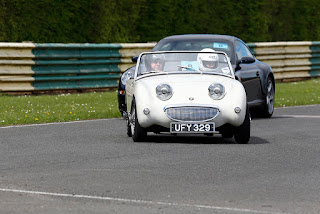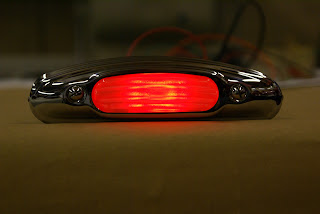Whilst the front sidelight / indicator combination worked in principle, it did need to be tidied up. First off I found some BA9 lamp holders and then some very high power 1W amber BA9 base, LED's on ebay from http://stores.ebay.co.uk/Wholesale-Xenon-Lights-Store in the USA at about £3.00 each. A short length of 1.125 inch hexagonal bar (again from ebay) had a pair of 1/4 inch slices cut off it.
 |
| Basic components for one side. Note tiny PhotoMOS Relay |
Three 10mm holes are then drilled to accommodate the lamp holders. These are a nice interference fit and a little superglue dribbled around the sides permanently fixes them in place.
 |
| Hex bar drilled to accept 10mm OD BA9 lamp holders |
Because the sidelight Cree type LED is so immensely bright, the indicator amber LEDs are nowhere near as crisp and distinct as when the side lights are off . This is especially noticeable when viewed head on due to the narrow angles of illumination. So whats required is for the sidelight to temporarily extinguish exactly as the indicator comes on, a job for a normally closed relay. Because the LED's draw such a small current (20mA) we can go one better and use a solid sate Photo-MOS type relay, small, very fast switching and hugely reliable.
For those unfamiliar with the operation of such things, here's how it works :
With the sidelights on, the 12V supply is connected to pin 4 and as the relay is normally closed, the supply continues to pin 3, illuminating the white sidelight LED. When 12 volts appears from the flasher unit, as well as going to, and illuminating the two amber LED's, it also goes through the 470 Ohm resistor to pin 1. This triggers the relay to change state to open circuit between pins 3 and 4 turning the sidelight off. If you want the sidelight to temporarily dim, then connecting a 1KOhm resistor across pins 3 and 4 will allow limited current flow.
 |
| Again, note tiny relay with pin 2 soldered onto common earth |
 |
| Heat shrink tidies it all up and prevents accidents |
If your 120 has the later sidelight arrangement where its not a separate item, I believe the aperture for the front lens is considerably wider at around 1 and 5/8 inches (the chrome item above is less than 1 inch) so the assembly should just fit nicely straight through the front, once the original lamp holder is removed.
I would have to say that the finished product worked superbly. The change to brilliant orange is so fast that your not aware the the sidelight has been extinguished and there is no way that anyone could mistake your intentions. Fitting the 1K resistor would technically leave the side light on but I think its better without it.
 |
| Sidelight around three times brighter than original filament lamp |
 |
| Photo makes indicator look yellow when its actually very bright orange / amber |
Number Plates
The general consensus seems to be that the original number plates were most likely but not necessarily made by Ace. Looking closely at the picture of my car when two weeks old, they do seem to look like Ace type cast aluminium numbers. These are still available from Framptons and I opt to buy the individual numbers in order to make up my own plates, thus getting the plate dimensions exactly right. This also saves me £80, but they are nevertheless expensive at £16.25 per number.
 |
| Easy solution to get the pin holes in exactly the right place |
 |
| Plate ready for powder coating satin black |
 |
| Numbers should possibly be little less shiny - time will sort |
 |
| Front end almost finished |
Miscellany
Two events since my last post. The first being a track day at Croft racing circuit. Feeling guilty about neglecting my frog-eye sprite, I spent some time giving it a general service and sort out and on the day it repaid me in spades having no trouble seeing off several TR's and even a modern MGF. (See post 21 - January 2012 to find out how this could be). Great weather for a change and a truly brilliant day which everyone enjoyed, even Nick who was black flagged on every session in his new Audi RS3. Your 66 Nick, (or is it 67) and I really think its about time you started to take some responsibility for your actions.
 |
| Frog-eye punching well above it's weight |
 |
| Porsche 911 - probably slip-streaming to gain an advantage |
 |
| CDEF - Possibly a photographic first? |
The second event turned out rather less memorable.
I volunteered to spend the day marshaling for the Jaguar Drivers Club annual rally last Saturday. This event had previously been organised and run by the same man for quite a number of years and I suspect that for some regular entrants, this was the extent of their world as far as rallying goes. For whatever reason, possibly because it was held in the North East, a new organiser was brought in. His brief was to put together a navigation / regularity event based on MSA regulations and licences and that is precisely what he did. Unfortunately, the gap between the expected event and previous experience of the competitors and the delivered event strictly in line with MSA regs was rather large. The new organisers not unreasonably assumed that the competitors were all seasoned and consummate enthusiasts whereas at least half were simply out for a pleasant Saturday afternoon sociable drive through Wensleydale. The best that can be said is that both organisers and competitors were equally unimpressed with each other.
The day was not helped by wind and rain spoiling the magnificent views on route. Additionally, the lunch stop at a Wensleydale Hotel further wound up the already exasperated assembly by charging a tenner a head for a mediocre bowl of soup and a Sandwich. By the time we got in from the rain after arranging the parking of the 45 cars, the soup was barely warm and the sandwiches had all been eaten. Worst of all, I had left my carefully prepared Mrs E's finest home made soup and ham sandwiches behind after the promise of a good buffet lunch at said eatery.












